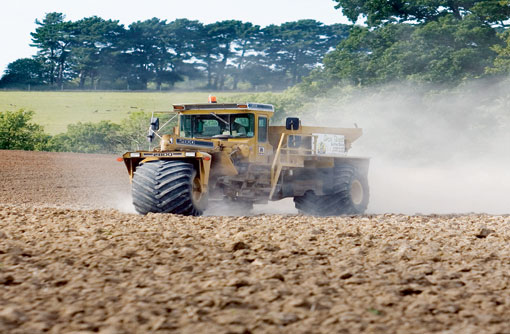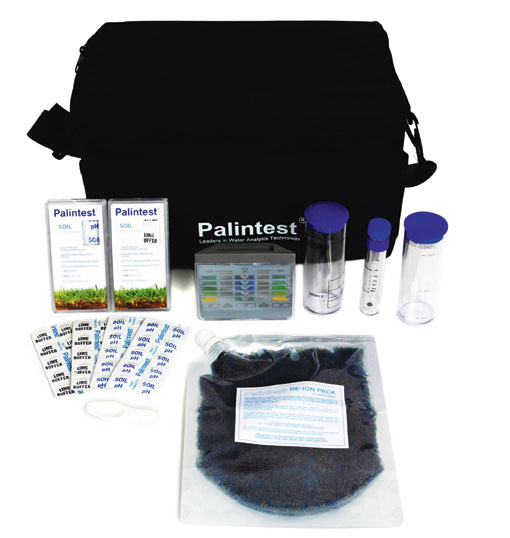Kits make lime testing realistic

With arable profits stronger than for some years is now the time to lime, and if so, should you do the field testing yourself?
Guidance on application rates is readily available in Defra’s RB209 Fertiliser Manual and computer software from Rothamsted Research and the Agricultural Lime Association (which also produces the Agricultural Lime booklet with rate recommendations).
Field testing is also straightforward, with a number of agricultural suppliers offering kits and a new range of soil test kits being launched at this year’s Cereals Event by Martin Lishman.
Edward Mack of Palintest says the company invested a lot of time and resources making the kits easy to use and as accurate as possible.
For the distributor, Gavin Lishman says: “The extraction and reagent tablets provided for each of the tests make analysis very simple and instructions are easy to follow.”
Typical on-farm requirements range from on-the-spot soil pH checks to checking for elements such as iron, copper, manganese and sulphur. Visual colour matching is used for the basic kits and photometry for high-end versions.
The base SK100 provides a two-stage test; one to determine soil pH, another for lime requirement – the quantity of liming material needed to lift pH to a specified value. Each stage involves adding a tablet (reagent and pH buffer, respectively) to a small quantity of soil mixed in a test tube with de-ionised water.
| Lime info • Application rate guidelines: DEFRA’s RB209 Fertiliser Manual, ALA’s Agricultural Lime booklet and calculator software (http://www.aglime.org.uk/limecalculator01.html) and Rothamsted Research RothLime calculator, which takes into account acid deposition (http://www.rothamsted.bbsrc.ac.uk/aen/rothlime/) |
|---|
What growers contemplating DIY liming evaluation may lack, of course, is the expertise to correctly sample and analyse results.
John Prentis of Cereals Event exhibitor R&T Liming emphasises that, apart from convenience, using a professional lime supplier taps into specialist expertise. “It takes experience to get these things right and obtain consistently representative samples and accurate analysis for different soils and situations.”
While traditional “W” sampling is quickest, easiest and cheapest, Mr Prentis advocates the more intensive grid pattern he uses to get a clear picture of soil pH variability. “On soils where pH tends to be very even, I’d normally take a sample every acre. But in typical Cambridgeshire soils, where pH is often more variable, I’ll take two to five samples an acre so lime can be applied at different rates, where appropriate.”
 The Palintest SK100 from Martin Lishman is the base kit in a range of visual colour matching and photometry soil test packages. It’s used for pH and lime requirement assessments. |
|---|
Growers relying on a single sample aggregated across a field – taken for P, K and Mg fertiliser assessment perhaps – lack that precision, notes consultant Peter Hoey.
“Soil acidity has such an adverse effect on crops that spot sampling is essential to reveal the true picture,” says Mr Hoey of Fieldfare Training. “Liming materials need to go on at the appropriate rate for the soil type and pH status.”
Material choice can lean to local sourcing, given haulage costs. But growers also need to consider neutralising value (a measure of effectiveness in countering acidity) and reactivity – how quickly that effect is achieved, which is influenced by particle size.
Suppliers of natural liming materials are required by the Fertilizer Regulations to declare these characteristics. Materials derived from industrial processes- such as sugar factory lime, slags and lime-treated sewage sludge – can only be applied by operators with an Environment Agency permit.
“Be aware of possible contaminants, such as the heavy metals that may be contained in cement kiln dust,” advises Stephen Hill of the Agricultural Lime Association, which represents a number of lime producers and suppliers, including manufacturers of fast-acting granulated or pelleted liming materials that can be used for urgent remedial treatments.
| At Cereals • The Fertilizer Company (D506), Environment Agency (I1008), Martin Lishman (J1122), National Association of Agricultural Contractors (G802), Omya (D514), R&T Liming (D516). |
|---|
Cereals Event exhibitors The Fertilizer Company (Calcifert) and Omya (Calciprill and Calciflow) use a binding agent to form a fertiliser-like granule; Needham Chalks supplies granulated soft chalk under the name NuCalc. All have high neutralising value and break down quickly with moisture to a fine material that provides rapid correction of excess acidity.
Although more expensive a tonne, suppliers argue that, if used little and often, these products can be competitive with regular liming materials applied every four to five years, and eliminate cyclical fluctuations in pH.
“They’re great for emergency treatments over a small area when soil analysis confirms symptoms of a struggling crop – poor germination, yellowing, spiky leaves on a cereal crop, poor growth,” notes Mr Hoey. “And because they can be applied through a farm fertiliser broadcaster, there’s no delay waiting for a spreading contractor.”

